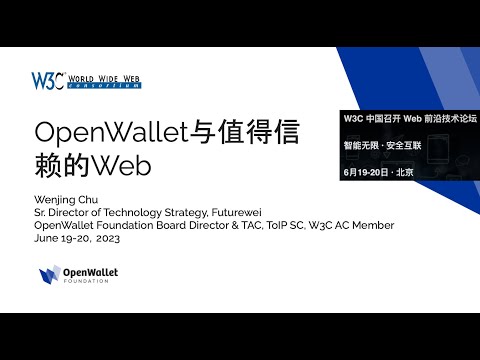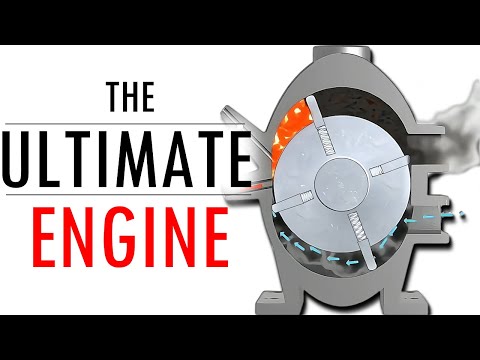Introduction to OpenWallet and the New Opportunities in A Trustworthy Web

I am Wenjing Chu, Senior Director of Technology Strategy at Futurewei, as well as a Board Director and TAC Member at OpenWallet Foundation. I also serve as a steering committee member of Trust over IP, an esteemed standard organization. Today, I am pleased to share my insights in three distinct parts. Firstly, I will provide an introduction to the OpenWallet open-source, shedding light on its mission, objectives, and organizational structure.
Moving forward, I will delve into the pivotal role of digital wallets in trusted web technologies and applications. Furthermore, I will present our innovative ideas to the esteemed experts at W3C. Lastly, I will explore opportunities at the forefront of technology. Specifically, I will examine the intricate relationship between digital wallets and web technologies. The OpenWallet Foundation, in simple terms, is a foundation established to support the development of interoperable open-source projects for digital wallets. Our vision is to create a globally-focused, open and neutral open-source community.
The initial preparations for the foundation began around September of last year at the Linux Foundation's Open Source Summit in Dublin, and we officially established the foundation in February of this year. We have a diverse membership, and I will mention some of them shortly. We warmly welcome participation from companies, organizations, in the Chinese region, and people from various standard organizations.
For more information, I have provided two links. The first contains information of the main preparatory stage in September, and the second link is for the official establishment in February. Firstly, I would like to provide a basic positioning of digital wallets. Our idea is that digital wallets serve numerous purposes and are relevant to various levels of issues. The diagram illustrates two main aspects.
Firstly, the wallet serves as a secure and trustworthy container, or a tool. Secondly, the object types or asset types within the wallet can be understood in different ways. For instance, one category is identification documents. The second category involves payment-related assets, such as credit cards or mobile payment methods. The third category is more broadly focused on various types of digital content and assets. Why do these contents and assets need to be stored within a wallet? Clearly, there are more rigorous requirements for controlling and managing these types of content, ones that general web browsers or traditional web browsers do not typically handle.
There are numerous examples of these digital contents, such as various types of tickets, keys, and contracts, including consent, which is a data management protocol, or agreements between different bodies. Additionally, we have content like videos, photos, movies, etc. These can occur across different computing devices, from Web to Mobile to Cloud, and require different types of hardware and headsets.
When considering a digital wallet in this context, there is a need for more extensive requirements, including flexibility in terms of component modules and so on. We believe that many standards already exist in various aspects, such as payment standards in the web, various types of IDs within Web, and the standards of W3C's Decentralized Identifiers. However, it is crucial to construct a truly deployable and user-friendly digital wallet that can incorporate these standards effectively and provide flexibility to support various types of asset structures. Such open-source software is currently lacking.
Let's take an open-source browser as an example to illustrate the concept. It consists of two main parts: the standardization work and the open-source engine, such as Blink, which serves as the foundation for various commercial browsers. The focus of our open-source community, similar to this example, is on the development of shareable core open-source modules.
The primary focus of OpenWallet lies in the development of core open-source modules that can be shared among users. These modules are built upon a comprehensive set of standards, some of which we have highlighted here. For instance, W3C's Verifiable Credentials and ISO's 18013 Mobile Driving Licence or mobile documents are excellent standards. EMVCo. provides protocols for credit cards and more.
We should also consider governmental or regulatory specifications, which sometimes function similarly to standards. Both the technical standards and these additional specifications need to be implemented within the software, creating a mechanism for their inclusion. By adhering to these standards and specifications, we can develop globally applicable open-source modules. In summary, our foundation's goal is to generate standardized open-source software components and promote them as best practices. These components can then be utilized by a wide range of organizations and institutions. These institutions can generally be categorized as follows: software providers, such as product providers; recipients, such as merchants; regulators, including data issuers, such as government departments issuing identification documents.
They collaborate to establish a new ecosystem that safeguards user privacy and offers users various commercial choices. Now, let me briefly explain the differences between wallets, browsers, and other software. The key distinction lies in their interoperability, as well as their high foundational requirements. We can examine these requirements from four different perspectives: legal, regulatory, business-related, and semantic and syntactic.
Additionally, there are communication protocol requirements. Given the complexity of this ecosystem, an international open-source community is crucial. Although our community is relatively new, it is rapidly growing. New members join us regularly, reflecting the dynamic nature of our organization. This data is from February and various companies and organizations have started to gradually propose the important building blocks and data types.
The first one is the EU's digital identity, eIDASz. It is closely related to the EU's AI legislation. The eIDASz has been in effect for a little over two years, but its application is expected to begin this year and next, making it relatively mature. In terms of technology, the EMV payment system is quite mature.
As for the ISO standards, as mentioned earlier, mDOC and mDL, mobile driving license, have already been implemented in several states in the US, with many countries planning to adopt these standards, including for driving licenses and other identification documents. The W3C also has a Verifiable Credential module, which is currently undergoing development for its second version. This module provides excellent privacy protection and is highly flexible in its application. So, there is a great deal of interest in implementing this standard. There are several more examples of different applications in various scenarios, showcasing a comprehensive set of functionalities being implemented. The second topic I will discuss is the pivotal role played by digital wallets.
The term "wallet" is simply used as an analogy to express the overall concept of a secure and trustworthy component. Abstractly speaking, it is a wallet that serves two main functions. Firstly, it serves as a repository for collecting important data. This data is not casually used and pertains to serious matters, such as certificates and financial transactions, which are substantial examples among many encountered frequently in our daily lives.
The wallet acts as a significant hub for gathering such critical data. Secondly, it facilitates the convenient use of these important data by the user. This is primarily achieved by granting individuals control over their data and enabling effortless utilization.
Only by encompassing these two aspects can the ultimate end-users truly have effective control over their data management. Hence, this abstract notion of a wallet serves as a highly direct and personalized interaction mechanism. From this perspective, it can be employed in various contexts, effectively exemplifying the privacy of data. Such manifestation is reflected in an individual's ability to directly manage such data, rather than relying on third-party custodianship.
It empowers individuals to exercise control over their own data. Therefore, we believe that the core software of such a digital wallet has the potential to become a key technology for the next generation of web applications. These new applications possess several characteristics, the first being high value. They demand a high level of privacy from users and require data authenticity and feasibility.
Now, let me quickly list some of these applications that illustrate these aspects. They encompass electronic identification, highly trusted financial services, electronic receipts, and genuine digital content, which I believe to be of utmost importance. On the internet, particularly with media data, it is generally untrustworthy. In other words, your credibility merely lies in the extent of scrutiny applied by the platform towards its content, making it a manual process that lacks complete automation. We aspire to achieve this functionality through a truly reliable and scalable protocol.
Additionally, there are many applications that have been talked about extensively but not yet fully realized. They require the foundational support of a high-trust digital wallet. This includes remote healthcare and even the concept of a metaverse, which greatly amplifies the quantity and value of private data. Therefore, without fundamentally addressing privacy concerns at the technological level, many real-world applications will remain challenging to implement. Similarly, applications involving AI are subject to the same.
Given the direct and extensive access to personal privacy data, AI applications necessitate technological safeguards that allow for effective self-management of privacy. Now, let's explore some examples of potential collaboration areas between OpenWallet and W3C. These examples are ones I am personally more familiar with, so there may surely be others that I have missed.
Nonetheless, I would like to share these with you for now. The first example relates to the W3C standards and their open-source implementation. One significant aspect is that while there have been various open-source initiatives in areas like VC and others, they have lacked substantial scalability and global adoption. Specifically, when it comes to Web Verifiable Credentials and DID Method, there is currently no comprehensive and universally accepted practical approach.
Therefore, I believe that OpenWallet could play a significant role in driving advancements in this area. Many individuals are genuinely interested in new decentralized VC standards, making it an intriguing field worth exploring. The second one pertains to the architecture of MiniApps. In the case of Wallet, you can observe that it has a container that encompasses different data object types.
Each object type represents a logical component of a mini-app's architecture. In this context, the Wallet serves as a secure core module for providing functionality to the mini-app architecture. Therefore, I believe there is immense potential for collaboration. Lastly, let's discuss the third point, which is the relationship between the Web Payment API, OpenWallet, and the Wallet. The Web Payment API is distinct from the Payment method itself, making them complementary to each other.
In other words, the Web Payment API is a way to implement payments within the Wallet. If you choose to build payment functionalities based on Web technology, the Wallet can serve as a tool or method for facilitating those payments. Therefore, I believe it is worth mentioning the involvement of the OpenWallet community as a means of implementation.
The OpenWallet foundation primarily focuses on open-source code and does not develop standards. Hence, we will collaborate with organizations like W3C and other specification bodies to find the best ways to implement these standards. Okay, next page.
Here is a quick overview of how to participate and register for these events. We are currently in the process of organizing a direct meeting and exchange during the Kubecon event in Shanghai, which we hope to hold in September. However, if you are interested in participating or learning more about the OpenWallet Foundation in any circumstance, please feel free to contact us at any time. I am available on WeChat, so you can reach out to us through any means of communication.
Thank you. Moving on to the next page, let's see if there are any questions. To summarize, we would like to introduce the OpenWallet Foundation to all of you and explain the role of the Wallet and its relationship with web browsers and web technologies.
We also want to identify areas for potential collaboration. Finally, we hope for your support and involvement in our community. Thank you. Thank you, Dr. Chu. Due to the constraints of time and online communication, I will select one question from the speech you just mentioned, which is about the metaverse that you briefly mentioned. I would like to inquire about the main application scenarios of OpenWallet within the metaverse.
OpenWallet has numerous application scenarios within the metaverse. I will mention a few of the simplest ones. For instance, in the metaverse, it is essential to have an avatar or other visual representation of your identity. This identity differs significantly from the authentication identity used for logging in, as it may have multiple properties.
These properties include your look and feel, which you need to control and own. Others should not be able to clone your avatar, among other things. Therefore, a comprehensive set of data asset management capabilities is required to realize your identity. This is a significant aspect within the metaverse.
The second category within the metaverse is that a significant amount of content is ultimately generated through AI or automatic mechanisms. It is crucial to determine who owns or manages these processes. The assets within the metaverse, for example, can have high costs and are considered high-value object types.
Therefore, you need a wallet to manage these assets and determine ownership and transfers. If you want to make transfers, you will need a payment system. All of these components are interconnected and form a crucial part of the metaverse. Open Metaverse, for instance, is another open-source organization that focuses on how to integrate this new identity system and asset management system.
But at the foundation of this system lies a wallet.
2023-08-28 14:28


